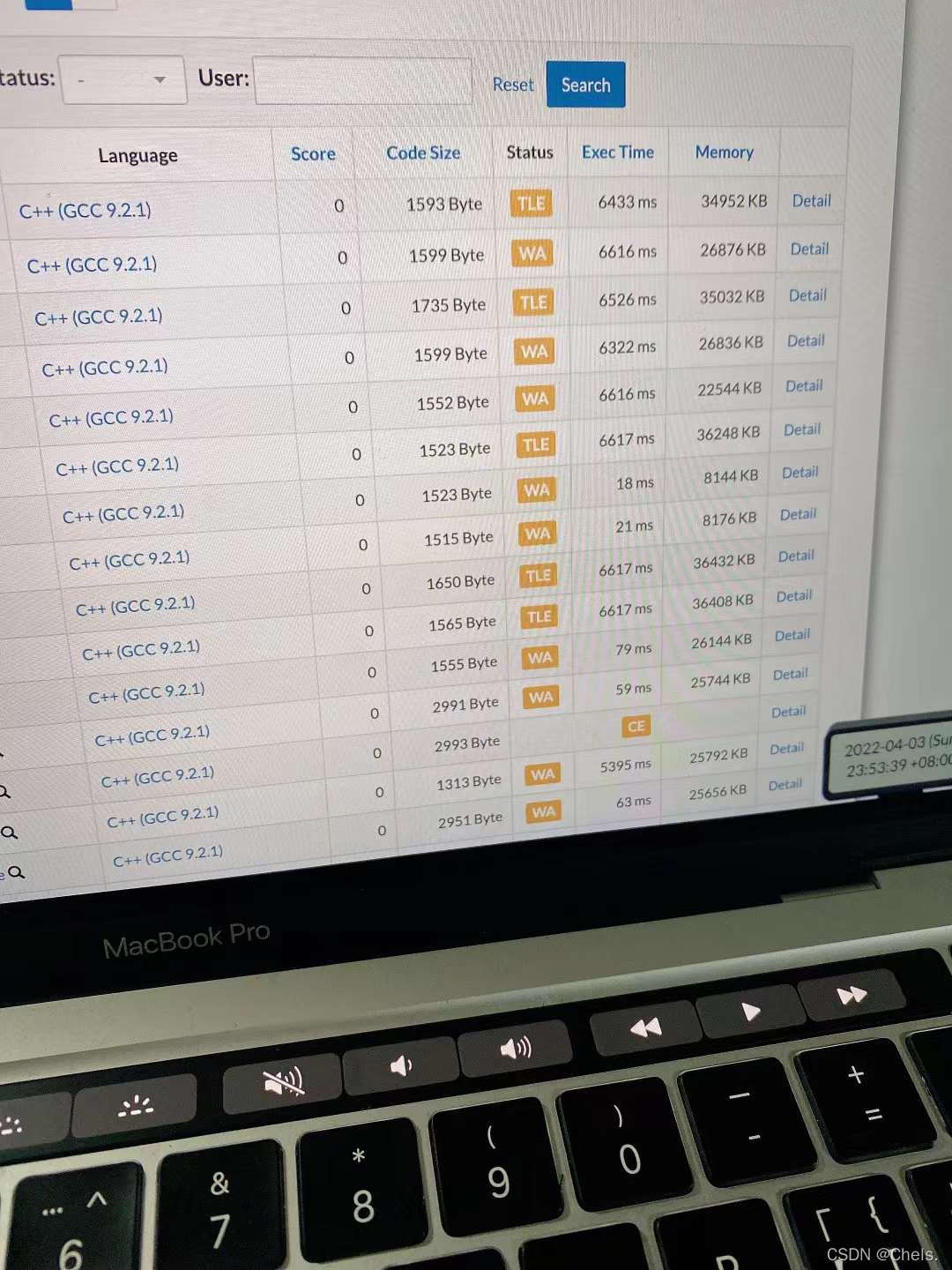E – Bishop 2
题目描述:
给你一个
n * n的矩阵,起点和终点确定,你只能沿对角线走,走的距离可以任意,但是从(x1, y1)走到(x2, y2)的过程中不能存在障碍物,且坐标必须合法,问最下需要几步能到达
思路:
经典bfs,第一反应是暴力bfs,四个方向,每个方向最多走n米…
这个题给了6秒,确实可以卡过去,不过很难卡:(
这个题可以用
01bfs来做,,每个点只需要扩展四周的点然后记录扩展的方向,如果方向相同那么边权就是0,方向不同边权就是1注意vis数组也要开四个状态进行记录!!!
暴力的bfs:
#include <bits/stdc++.h>
using namespace std;
#define endl '\n'
#define inf 0x3f3f3f3f
#define mod7 1000000007
#define mod9 998244353
#define m_p(a,b) make_pair(a, b)
#define mem(a,b) memset((a),(b),sizeof(a))
#define io ios::sync_with_stdio(false); cin.tie(0); cout.tie(0)
#define debug(a) cout << "Debuging...|" << #a << ": " << a << "\n";
typedef long long ll;
typedef pair <int,int> pii;
#define MAX 1500 + 50
int n, m, k;
int sx, sy, ex, ey;
char tr[MAX][MAX];
int dx[] = {1, 1, -1, -1};
int dy[] = {1, -1, 1, -1};
bool vis[MAX][MAX];
int ans[MAX][MAX];
pii q[5000000];
void bfs(){
int fr = -1, ed = 0;
q[++fr] = m_p(sx, sy);
ans[sx][sy] = 0;
while (ed <= fr) {
auto now = q[ed++];
if(now.first == ex && now.second == ey){
cout << ans[ex][ey] << endl;
return;
}
vis[now.first][now.second] = 1;
for(int i = 0; i < 4; ++i){
for(pii st = {now.first + dx[i], now.second + dy[i]};;st.first += dx[i], st.second += dy[i]){
if(st.first > n || st.first < 1 ||
st.second > n || st.second < 1||
vis[st.first][st.second]||
tr[st.first][st.second] == '#')break;
if(ans[st.first][st.second] != -1)continue;
ans[st.first][st.second] = ans[now.first][now.second] + 1;
q[++fr] = st;
}
}
}
cout << -1 << endl;
}
void work(){
cin >> n;
mem(ans, -1);
cin >> sx >> sy >> ex >> ey;
if(sx + sy + ex + ey & 1){
puts("-1");
return;
}
for(int i = 1; i <= n; ++i)scanf("%s", tr[i] + 1);
bfs();
}
int main(){
work();
return 0;
}
优美的01bfs
#include <bits/stdc++.h>
using namespace std;
#define endl '\n'
#define inf 0x3f3f3f3f
#define mod7 1000000007
#define mod9 998244353
#define m_p(a,b) make_pair(a, b)
#define mem(a,b) memset((a),(b),sizeof(a))
#define io ios::sync_with_stdio(false); cin.tie(0); cout.tie(0)
#define debug(a) cout << "Debuging...|" << #a << ": " << a << "\n";
typedef long long ll;
typedef pair <int,int> pii;
#define MAX 1500 + 50
int n, m, k;
char tr[MAX][MAX];
int sx, sy, ex, ey;
int dx[] = {1, 1, -1, -1};
int dy[] = {1, -1, 1, -1};
struct ran{
int op, x, y, step;
};
bool vis[MAX][MAX][4];
bool judge(int x, int y, int op){
if(x > n || x < 1 || y > n || y < 1)return false;
else if(vis[x][y][op])return false;
else if(tr[x][y] == '#')return false;
else return true;
}
void bfs(){
deque<ran>q;
q.push_back({-1, sx, sy, 0});
while (!q.empty()) {
auto [op, x, y, step] = q.front();q.pop_front();
if(x == ex && y == ey){
cout << step << endl;
return;
}
for(int i = 0; i < 4; ++i){
int xx = x + dx[i];
int yy = y + dy[i];
if(!judge(xx, yy, i))continue;
vis[x][y][op] = 1;
if(i == op)q.push_front({i, xx, yy, step});
else q.push_back({i, xx, yy, step + 1});
}
}
cout << -1 << endl;
}
void work(){
cin >> n >> sx >> sy >> ex >> ey;
if(sx + sy + ex + ey & 1){
cout << -1 << endl;
return;
}
for(int i = 1; i <= n; ++i){
for(int j = 1; j <= n; ++j){
cin >> tr[i][j];
}
}
bfs();
}
int main(){
io;
work();
return 0;
}

